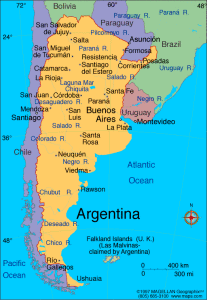Argentina
Fast Facts
Official Name: Argentine Republic
Form of Government: Republic
Capital: Buenos Aires
Population: 43,024,374
Official Languages: Spanish
Money: Argentine peso
Area: 1,073,364 square miles (2,780,400 square kilometers)
What You Should Know
In 1816, the United Provinces of the Rio Plata declared their independence from Spain. After Bolivia, Paraguay, and Uruguay went their separate ways, the area that remained became Argentina. The country's population and culture were heavily shaped by immigrants from throughout Europe, with Italy and Spain providing the largest percentage of newcomers from 1860 to 1930. Up until about the mid-20th century, much of Argentina's history was dominated by periods of internal political conflict between Federalists and Unitarians and between civilian and military factions.
Visitors from all countries are required to have a passport to enter Argentina, although Australians and New Zealanders must also have a visa. There are no required vaccines to enter Argentina.
Mar del Plata, on the southern Atlantic coast about 400 km (250 mi) from Buenos Aires, is the most popular ocean resort. The delta of the Río Paraná, forming a series of inland waterways, is a center for pleasure boats and launches. Córdoba, with its fine colonial cathedral, and nearby Alta Gracia attracts many visitors. San Carlos de Bariloche, at the entrance to Nahuel Huapi National Park in the Andean lake region of western Patagonia, has become famous as a summer and winter resort, with some of the best skiing in the Southern Hemisphere. The Iguazú Falls, in the province of Misiones, on the border of Argentina and Brazil, is a major tourist attraction. Mendoza, situated in a fertile oasis below the towering Andes, offers such historical attractions as the Cerro de la Gloria, with its monument to San Martín, and the Historical Museum, with its collection on San Martín.
The most popular sport is football (soccer). Tennis, rugby, basketball, and golf are also played. Opportunities for gambling include a weekly lottery, football pools, horse racing at the Palermo and San Isidro tracks (in Buenos Aires), and the casino at Mar del Plata, whose profits go to the Ministry of Social Welfare.
Geography
Second in South America only to Brazil in size and population, Argentina is a plain, rising from the Atlantic to the Chilean border and the towering Andes peaks. Aconcagua (22,834 ft, 6,960 m) is the highest peak in the world outside Asia. Argentina is also bordered by Bolivia and Paraguay on the north, and by Uruguay and Brazil on the east. The northern area is the swampy and partly wooded Gran Chaco, bordering Bolivia and Paraguay. South of that are the rolling, fertile Pampas, which are rich in agriculture and sheep- and cattle-grazing and support most of the population. Further south is Patagonia, a region of cool, arid steppes with some wooded and fertile sections.
Climate
Argentina's climate is generally temperate, but there are great variations, from the extreme heat of the northern Chaco region, through the pleasant mild climate of the central pampas, to the subantarctic cold of the glacial regions of southern Patagonia. The highest temperature, 49°c (120°f), was recorded in the extreme north, and the lowest,–16°c (3°f), in the southern tip of the country. Rainfall diminishes from east to west. Rainfall at Buenos Aires averages 94 cm (37 in) annually, and the mean annual temperature is 16°c (61°f). Light snowfalls occur occasionally in Buenos Aires. Throughout Argentina, January is the warmest month and June and July are the coldest. North of the Río Negro, the winter months (May–August) are the driest period of the year. The wide variations of climate are due to the great range in altitude and the vast extent of the country. In the torrid zone of the extreme north, for example, the Chaco area has a mean annual temperature of about 23°c (73°f) and a rainfall of about 76 cm (30 in), whereas Puna de Atacama has a temperature average of 14°c (57°f) and a rainfall of about 5 cm (2 in). The pampas, despite their immensity, have an almost uniform climate, with much sunshine and adequate precipitation. The coldest winters occur not in Tierra del Fuego, which is warmed by ocean currents, but in Santa Cruz Province, where the July average is 0°c (32°f).




